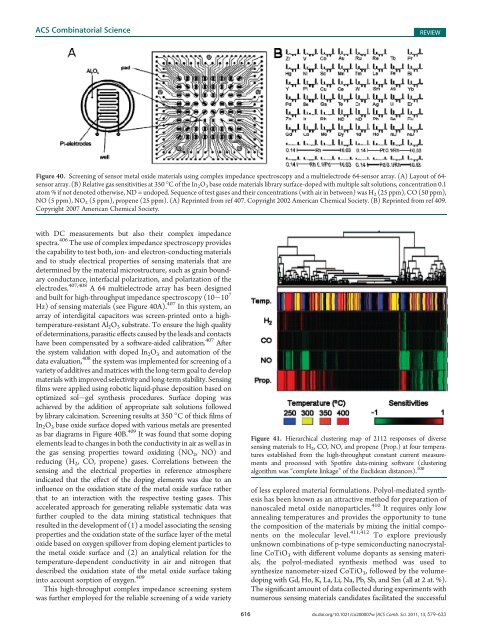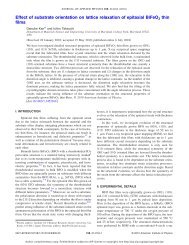Combinatorial and High-Throughput Screening of Materials ...
Combinatorial and High-Throughput Screening of Materials ...
Combinatorial and High-Throughput Screening of Materials ...
You also want an ePaper? Increase the reach of your titles
YUMPU automatically turns print PDFs into web optimized ePapers that Google loves.
ACS <strong>Combinatorial</strong> Science<br />
REVIEW<br />
Figure 40. <strong>Screening</strong> <strong>of</strong> sensor metal oxide materials using complex impedance spectroscopy <strong>and</strong> a multielectrode 64-sensor array. (A) Layout <strong>of</strong> 64-<br />
sensor array. (B) Relative gas sensitivities at 350 °C <strong>of</strong> the In 2 O 3 base oxide materials library surface-doped with multiple salt solutions, concentration 0.1<br />
atom % if not denoted otherwise, ND = undoped. Sequence <strong>of</strong> test gases <strong>and</strong> their concentrations (with air in between) was H 2 (25 ppm), CO (50 ppm),<br />
NO (5 ppm), NO 2 (5 ppm), propene (25 ppm). (A) Reprinted from ref 407. Copyright 2002 American Chemical Society. (B) Reprinted from ref 409.<br />
Copyright 2007 American Chemical Society.<br />
with DC measurements but also their complex impedance<br />
spectra. 406 The use <strong>of</strong> complex impedance spectroscopy provides<br />
the capability to test both, ion- <strong>and</strong> electron-conducting materials<br />
<strong>and</strong> to study electrical properties <strong>of</strong> sensing materials that are<br />
determined by the material microstructure, such as grain boundary<br />
conductance, interfacial polarization, <strong>and</strong> polarization <strong>of</strong> the<br />
electrodes. 407,408 A 64 multielectrode array has been designed<br />
<strong>and</strong> built for high-throughput impedance spectroscopy (10 10 7<br />
Hz) <strong>of</strong> sensing materials (see Figure 40A). 407 In this system, an<br />
array <strong>of</strong> interdigital capacitors was screen-printed onto a hightemperature-resistant<br />
Al 2 O 3 substrate. To ensure the high quality<br />
<strong>of</strong> determinations, parasitic effects caused by the leads <strong>and</strong> contacts<br />
have been compensated by a s<strong>of</strong>tware-aided calibration. 407 After<br />
the system validation with doped In 2 O 3 <strong>and</strong> automation <strong>of</strong> the<br />
data evaluation, 408 the system was implemented for screening <strong>of</strong> a<br />
variety <strong>of</strong> additives <strong>and</strong> matrices with the long-term goal to develop<br />
materials with improved selectivity <strong>and</strong> long-term stability. Sensing<br />
films were applied using robotic liquid-phase deposition based on<br />
optimized sol gel synthesis procedures. Surface doping was<br />
achieved by the addition <strong>of</strong> appropriate salt solutions followed<br />
by library calcination. <strong>Screening</strong> results at 350 °C<strong>of</strong>thickfilms <strong>of</strong><br />
In 2 O 3 base oxide surface doped with various metals are presented<br />
as bar diagrams in Figure 40B. 409 It was found that some doping<br />
elements lead to changes in both the conductivity in air as well as in<br />
the gas sensing properties toward oxidizing (NO 2 , NO) <strong>and</strong><br />
reducing (H 2 , CO, propene) gases. Correlations between the<br />
sensing <strong>and</strong> the electrical properties in reference atmosphere<br />
indicated that the effect <strong>of</strong> the doping elements was due to an<br />
influence on the oxidation state <strong>of</strong> the metal oxide surface rather<br />
that to an interaction with the respective testing gases. This<br />
accelerated approach for generating reliable systematic data was<br />
further coupled to the data mining statistical techniques that<br />
resulted in the development <strong>of</strong> (1) a model associating the sensing<br />
properties <strong>and</strong> the oxidation state <strong>of</strong> the surface layer <strong>of</strong> the metal<br />
oxide based on oxygen spillover from doping element particles to<br />
the metal oxide surface <strong>and</strong> (2) an analytical relation for the<br />
temperature-dependent conductivity in air <strong>and</strong> nitrogen that<br />
described the oxidation state <strong>of</strong> the metal oxide surface taking<br />
into account sorption <strong>of</strong> oxygen. 409<br />
This high-throughput complex impedance screening system<br />
was further employed for the reliable screening <strong>of</strong> a wide variety<br />
Figure 41. Hierarchical clustering map <strong>of</strong> 2112 responses <strong>of</strong> diverse<br />
sensing materials to H 2 , CO, NO, <strong>and</strong> propene (Prop.) at four temperatures<br />
established from the high-throughput constant current measurements<br />
<strong>and</strong> processed with Spotfire data-mining s<strong>of</strong>tware (clustering<br />
algorithm was “complete linkage” <strong>of</strong> the Euclidean distances). 100<br />
<strong>of</strong> less explored material formulations. Polyol-mediated synthesis<br />
has been known as an attractive method for preparation <strong>of</strong><br />
nanoscaled metal oxide nanoparticles. 410 It requires only low<br />
annealing temperatures <strong>and</strong> provides the opportunity to tune<br />
the composition <strong>of</strong> the materials by mixing the initial components<br />
on the molecular level. 411,412 To explore previously<br />
unknown combinations <strong>of</strong> p-type semiconducting nanocrystalline<br />
CoTiO 3 with different volume dopants as sensing materials,<br />
the polyol-mediated synthesis method was used to<br />
synthesize nanometer-sized CoTiO 3 , followed by the volumedoping<br />
with Gd, Ho, K, La, Li, Na, Pb, Sb, <strong>and</strong> Sm (all at 2 at. %).<br />
The significant amount <strong>of</strong> data collected during experiments with<br />
numerous sensing materials c<strong>and</strong>idates facilitated the successful<br />
616 dx.doi.org/10.1021/co200007w |ACS Comb. Sci. 2011, 13, 579–633












